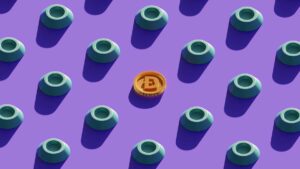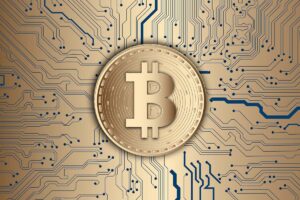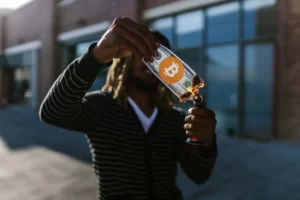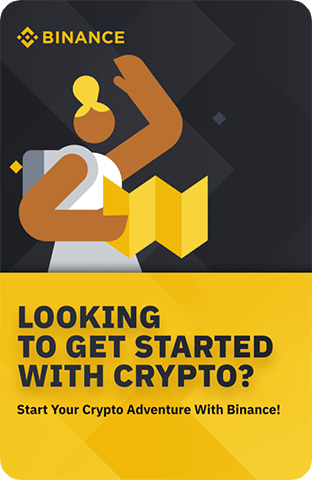Bitcoin is a digital money that runs independently of any person, organization, or entity, giving it a decentralized method of exchange. The world’s most well known cryptocurrency was first developed in 2009 by an unidentified developer or group of developers going by the moniker Satoshi Nakamoto.
Bitcoin may be acquired on various exchanges and pays blockchain miners for authenticating transactions. This article will look at the benefits, hazards, and history of BTC as well as how it may be mined and purchased.
In a Nutshell
- Bitcoin is a decentralized virtual currency that works independently of any person, organization, or body.
- It is available for purchase on numerous exchanges and pays blockchain miners for validating transactions.
- Blockchain technology, a distributed ledger that holds data and is secured by encryption techniques, is what Bitcoin employs.
- You need specific hardware and software to mine Bitcoin, or you can join a mining pool.
- Bitcoin can be used as a form of investment or as a means of exchange for goods and services, but its value is extremely erratic and involves dangers by nature.
- Although it is still a difficult and developing area, the US government is making an effort to regulate Bitcoin.
Understanding Bitcoin
In August 2008, the domain name Bitcoin.org was registered. Today, at least, this domain is protected by WhoisGuard, which means that the identity of the person who registered it is not public information.
Bitcoin is a technological tour de force.
Bill Gates
In October 2008, a person or group using the fake name of Satoshi Nakamoto announced on the cryptocurrency mailing list at metzdowd.com: “I have been working on a new electronic cash system that is entirely peer to peer, with no trusted third parties. This now famous white paper published on Bitcoin.org, titled “Bitcoin: A Peer to Peer Electronic Cash System”, would become the Magna Carta of Bitcoin’s current operation.
On January 3, 2009, the first Bitcoin block was mined: Block 0. It is also known as the “genesis block” and contains the text: “The Times 03/Ene/2009 Chancellor on brink of second bailout for banks”, perhaps as proof that the block was mined on or after that date, and perhaps also as relevant political commentary.
Bitcoin rewards are halved every 210,000 blocks. For example, the reward per block was 50 new bitcoins in 2009. On May 11, 2020, the third halving occurred, bringing the reward per discovered block down to 6.25 bitcoins.
One bitcoin is divisible to eight decimal places (100 millionths of a bitcoin), and this smaller unit is called a satoshi. If necessary, and if participating miners accept the change, bitcoin could become divisible to more decimal places.Bitcoin, as a form of digital currency, is not too complicated to understand. For example, if you own bitcoin, you can use your cryptocurrency wallet to send smaller portions of that bitcoin as payment for goods or services. However, it becomes very complex when you try to understand how it works.
On January 8, 2009, the first version of the Bitcoin software was announced on the cryptocurrency mailing list, and on January 9, 2009, Block 1 was mined, and Bitcoin mining began in earnest.
Bitcoin Blockchain Technology
Cryptocurrencies are part of a blockchain and the network needed to power it. A blockchain is a distributed ledger, a shared database that stores data. The data on the blockchain is protected by encryption methods.
When a transaction occurs on the blockchain, the information from the previous block is copied into a new block with the new data, encrypted and the transaction is verified by the network’s validators, called miners. When a transaction is verified, a new block is opened and a Bitcoin is created, which is given as a reward to the miner or miners who verified the data within the block.
Bitcoin uses the SHA 256 hash algorithm to encrypt data stored in blocks on the blockchain. Simply put, the transaction data stored in a block is encrypted in a 256 bit hexadecimal number. That number contains all the transaction data and information linked to the blocks before that block.The data linked between blocks is what has led to the ledger being called blockchain.
Transactions are placed in a queue to be validated by the network’s miners. All miners on the Bitcoin blockchain network attempt to verify the same transaction simultaneously. Mining software and hardware work to resolve the nonce, a four byte number included in the block header that miners attempt to resolve.
A miner performs a hash or random regeneration of the block header repeatedly until it reaches a target number specified by the blockchain. The block header is “resolved” and a new block is created to encrypt and verify further transactions.
How to Mine Bitcoin
A variety of hardware and software can be used to mine Bitcoin. When Bitcoin was first released, it was possible to mine it competitively on a personal computer; however, as it became more popular, more miners joined the network, which reduced the chances of being the one to solve the hash. You can still use your personal computer as a miner if it has newer hardware, but the chances of solving a hash individually are minuscule.
This is because you are competing with a network of miners that generate around 220 quintillion hashes (220 exa hashes) per second. The machines, called Application Specific Integrated Circuits (ASICs), are built specifically for mining and can generate around 255 trillion hashes per second. In contrast, a computer with the most modern hardware generates about 100 mega hashes per second (100 million).
To become a Bitcoin miner, you have several options. You can use your personal computer to use Bitcoin compatible mining software and join a mining pool. Mining pools are groups of miners who combine their computational power to compete with large ASIC mining farms.
You increase your chances of being rewarded by joining a pool, but the rewards decrease considerably because they are shared.If you have the financial means, you can also purchase an ASIC miner. You can usually find a new one for about $20,000, but miners also sell used miners when they upgrade their systems. If you purchase one or more ASICs, you will need to consider some important costs, such as electricity and cooling.
There are several mining programs to choose from and many pools to join. Two of the most popular programs are CGMiner and BFGMiner. When choosing a pool, it is important to make sure how they pay rewards, what the commissions are and read some mining pool reviews.
How to Buy Bitcoin?
If you don’t want to mine bitcoin, you can buy it on a cryptocurrency exchange. Most people won’t be able to buy a whole BTC due to its price, but you can buy portions of BTC on these exchanges in fiat currency such as US dollars. For example, you can buy bitcoin on Coinbase by creating an account and funding it. You can fund your account using your bank account, credit card or debit card. The following video explains more about buying bitcoin.
How is Bitcoin Used?
Bitcoin was initially designed and launched as a peer to peer payment method. However, its use cases are growing due to its increasing value and competition from other blockchains and cryptocurrencies.
Payment
To use your Bitcoin, you need to have a cryptocurrency wallet. The wallets contain the private keys to the bitcoins you own, which you must enter when you make a transaction. Bitcoin is accepted as a means of payment for goods and services at many merchants, retailers and stores.
Physical stores that accept cryptocurrencies usually display a sign that says “Bitcoin is accepted here”; transactions can be handled with the required physical terminal or wallet address via QR codes and touchscreen applications. An online business can easily accept Bitcoin by adding this payment option to its other online payment options: credit cards, PayPal, etc.El Salvador became the first country to officially adopt Bitcoin as legal tender in June 2021.
Investing and Speculating
Investors and speculators became interested in bitcoin as its popularity grew. Between 2009 and 2017, cryptocurrency exchanges emerged that facilitated the buying and selling of bitcoins. Prices began to rise and demand slowly grew until 2017, when its price surpassed $1,000. Many people believed that bitcoin prices would continue to rise and started buying them to keep them.
Traders started using cryptocurrency exchanges for short term trading, and the market took off.In 2022, the price of Bitcoin plummeted. In March 2022, it reached $47,454, and in November 2022 it stood at $15,731. Bitcoin’s fall is partly due to further market turmoil related to inflation, rising interest rates, Covid’s supply chain problems and the war in Ukraine. In addition, some major tokens have plummeted in the cryptocurrency world, as well as one of the major exchanges, raising concerns about the stability of digital currencies.
Risks of Investing in Bitcoin
Bitcoin’s all time high price is $68,990, reached in November 2021.Thus, many people buy Bitcoin for its value as an investment rather than for its ability to act as a medium of exchange. However, the lack of guaranteed value and its digital nature mean that its purchase and use carry several inherent risks. For example, the Securities and Exchange Commission (SEC), the Financial Industry Regulatory Authority (FINRA) and the Consumer Financial Protection Bureau (CFPB) have issued numerous warnings to investors regarding investing in BTC.
- Regulatory risk: The lack of uniform regulations on BTC (and other virtual currencies) raises questions about their longevity, liquidity and universality.
- Security risk: Most people who own and use BTC have not acquired their tokens through mining operations. Instead, they buy and sell BTC and other digital currencies on popular online marketplaces known as cryptocurrency exchanges. BTC exchanges are entirely digital and, like any virtual system, are exposed to the risk of hackers, malware and operational failures.
- Insurance Risk: BTC and cryptocurrencies are not insured through the Securities Investor Protection Corporation (SIPC) or the Federal Deposit Insurance Corporation (FDIC). Some exchanges provide insurance through third parties. In 2019, prime dealer and exchange platform SFOX announced that it may offer BTC investors FDIC insurance, but only for the portion of transactions involving cash.
- Fraud risk: Even with the inherent security measures within a blockchain, there are still opportunities for fraudulent activity. For example, in July 2013, the SEC took legal action against a BTC related Ponzi scheme operator.
- Market Risk: As with any investment, BTC values can fluctuate. In fact, the value of the currency has experienced large swings during its short existence. Subject to a large volume of buying and selling on the exchanges, it is very sensitive to any newsworthy event. According to the CFPB, the BTC price fell 61% in a single day in 2013, while the record single day price drop in 2014 was as much as 80%.
- The BTC has become one of the most expensive currencies in the world.
BTC Regulation
As with any new technology, attempts to regulate BTC have been difficult. The current Biden administration is trying to impose regulations around BTC, but at the same time walking a tightrope trying not to strangle a growing and economically beneficial industry.
Biden has stated that he will try to prevent the illegal use of BTC, but will also support its development. The US has been particularly focused on regulating cryptocurrencies and their criminal use abroad, for example by sanctioning cryptocurrency exchanges and individual cryptocurrency wallets and recovering cryptocurrency payments made to criminals. There have also been calls for the US to develop a central bank digital currency (CBDC) to properly target these sanctions.
As the world of BTC and cryptocurrencies emerges, so will regulation, which will see many changes and laws over time.
Wrap Up
The conventional financial system has been completely disrupted by the revolutionary technology known as Bitcoin. Many alternative cryptocurrencies and new financial technologies have been developed as a result of its decentralized structure and blockchain technology. Although BTC has the potential to be a profitable investment, it is crucial to thoroughly weigh the risks and speak with a financial expert before making a decision. Regulation and legislation will change as the world of BTC and other cryptocurrencies does, making this a fascinating and dynamic subject to watch.
FAQs

A cryptocurrency, such as BTC, is a digital currency intended to function as money and a means of payment independent of any person, group, or entity. As a result, it eliminates the need for third parties to be involved in financial transactions. It is available for purchase on a number of exchanges and compensates blockchain miners for their efforts in confirming transactions.
Blockchain technology, a distributed ledger used by BTC, stores data. The information from the previous block is replicated into the new block with the new data during a transaction on the blockchain, which is then encrypted and validated by network validators known as miners. A new block is formed when a transaction is validated, and the miner or miners who validated the data in the block are rewarded with a BTC.
BTC mining uses a wide range of hardware and software. On a personal computer, it was possible to mine BTC competitively when it first came out; however, as it gained popularity, more miners joined the network, lowering the likelihood of being the one to solve the hash. If your own computer has modern hardware, you can still use it to mine, but your odds of successfully solving a hash on your own are extremely slim. You have a variety of alternatives for how to mine bitcoins. You can use Bitcoin compatible mining software on your home computer and sign up for a mining pool. Mining pools are collections of miners who pool their processing power to take on massive ASIC mining farms.
If mining is not your thing, you can purchase BTC on a cryptocurrency exchange. Due to its high price, the majority of buyers won’t be able to purchase a whole BTC, but you can purchase chunks of BTC on these exchanges using fiat money like US dollars. For instance, by setting up an account and funding it, you can purchase BTC on Coinbase. Your bank account, credit card, or debit card can all be used to fund your account.
The short investment history of BTC is marked by extreme price volatility. Depending on your financial profile, investment portfolio, risk tolerance, and investing goals, it may or may not be a good investment. Always seek the advice of a financial expert before investing in cryptocurrencies to ensure that it is the best choice for your situation.
The mining network takes an average of 10 minutes to validate a block and create the reward. The Bitcoin reward is 6.25 BTC per block. This is equivalent to about 100 seconds to mine 1 BTC.
BTC has a short investment history filled with very volatile prices. Whether it is a good investment depends on your financial profile, your investment portfolio, your risk tolerance and your investment objectives. Before investing in cryptocurrencies, always consult a financial professional to make sure it is the right investment for your circumstances.
The BTC miner network makes money from BTC by successfully validating blocks and receiving a reward. Bitcoins can be exchanged for fiat currency through cryptocurrency exchanges and can be used to make purchases at merchants and retailers that accept them. Investors and speculators can make money by buying and selling bitcoins.
Article sources
At Capital Maniacs, we are committed to providing accurate and reliable information on a wide range of financial topics. In order to achieve this, we rely on the use of primary sources and corroborated secondary sources to support the content of our articles.
Primary sources, such as financial statements and government reports, provide firsthand evidence of financial events and trends. By using primary sources, we are able to directly reference information provided by the organizations and individuals involved in these events.
Secondary sources, such as financial analysis and commentary, interpret and analyze primary sources. While these sources can be useful for providing context and background information, it is important to use corroborated sources in order to ensure the accuracy and reliability of the information we present.
We take pride in properly citing all of our sources, both primary and secondary, in order to give credit to the original authors and to allow our readers to verify the information for themselves. We appreciate your trust in our website and are committed to upholding the highest standards of financial journalism.
- CoinTelegraph – Who Is the Mysterious Bitcoin Creator Satoshi Nakamoto?
- BTC Project – Bitcoin Is 10 Years Old!
- Satoshi Nakamoto – Bitcoin: A Peer-to-Peer Electronic Cash System
- Bitcoin.com – 10 Years Ago Bitcoin’s Genesis Block Changed the Course of History
- CoinTelegraph – Bitcoin Halving: How It Works and Why It Matters
- Nasdaq Data Link – Bitcoin Hash Rate
- Nicehash – Profitability Calculator
- Reuters – In a World First, El Salvador Makes Bitcoin Legal Tender
- Google Finance – Bitcoin to United States Dollar
- Coinbase – Bitcoin Price
- CoinTelegraph – Crypto Prime Dealer SFOX Partners With New York Bank to Offer New FDIC Protection
- U.S. Securities and Exchange Commission – SEC Charges Texas Man With Running Bitcoin-Denominated Ponzi Scheme
- Consumer Financial Protection Bureau – Risks to Consumers Posed by Virtual Currencies
- Brookings – The Competing Priorities Facing U.S. Crypto Regulations
- Buy BTC Worldwide – How Many Bitcoins Are There?























